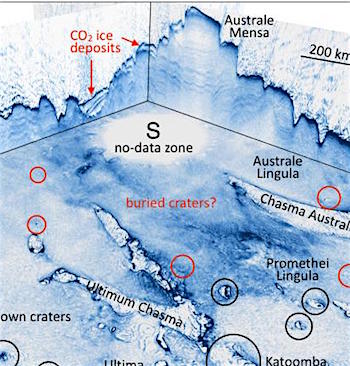 Three-dimensional (3-D) subsurface radar volumes generated from thousands of 2-D radar profiles are revealing new information about the polar regions of Mars, including more accurate mapping of CO2 and water ices, the discovery of buried impact craters, and new elevation data. PSI Senior Scientist Nathaniel E. Putzig is the lead author of the new Icarus paper “Three-dimensional radar imaging of structures and craters in the Martian polar caps.”
Three-dimensional (3-D) subsurface radar volumes generated from thousands of 2-D radar profiles are revealing new information about the polar regions of Mars, including more accurate mapping of CO2 and water ices, the discovery of buried impact craters, and new elevation data. PSI Senior Scientist Nathaniel E. Putzig is the lead author of the new Icarus paper “Three-dimensional radar imaging of structures and craters in the Martian polar caps.”
This information will help scientists better understand Martian climate changes and may allow them to determine the age of the polar caps without using climate models. The 3-D data volumes were assembled from observations by the Shallow Radar (SHARAD) sounder onboard NASA’s Mars Reconnaissance Orbiter (MRO) during more than 2,000 passes over each Martian pole.
“An example is the more accurate mapping of the CO2 ice deposits in the south that allows us to provide a new, larger estimate of their volume. Sublimation of that CO2 ice into the atmosphere – which is thought to have occurred at various times in Martian history – would more than double the current atmospheric pressure,” said Putzig. “That in turn would allow liquid water to be stable at the surface in many more locations than it is today.”
One type of feature in the polar caps that was never detected or mapped with single-orbit radar profiles is buried impact craters. “In the 3D radar volumes, we can identify and map bowl-shaped features that appear to be buried impact craters, many of them at the base of the icy layers,” Putzig said. “To estimate the age of planetary surfaces, scientists combine information about the number, size, and distribution of craters and knowledge of cratering rates over time within the Solar System.
“Our analysis of the apparent craters at the base of the northern cap yields an age of about 3.5 billion years, which is consistent with the previously estimated age for the surrounding plains from surface cratering statistics,” Putzig said. “This overall agreement gives us greater confidence in identifying buried craters as we continue to search for them within the ices and beneath the southern cap.” [More at links]








